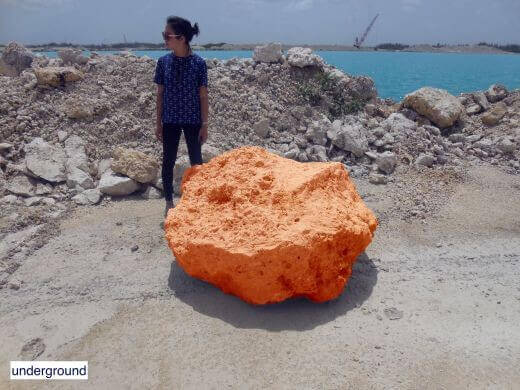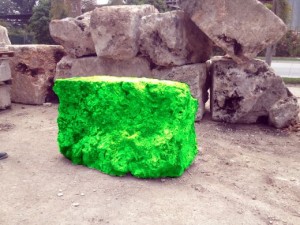Jedediah Caesar with Diana Nawi
Diana Nawi
 Jedediah Caesar, research images. Courtesy the artist
Jedediah Caesar, research images. Courtesy the artist
DIANA NAWI (MIAMI RAIL): How did you approach this work? In a literal way, what were your first steps in conceptualizing this project for Locust?
JEDIDIAH CAESAR: This project came out of a project I did in 2012 at LA>
between landscape, objects, and language were collapsed.
So I had this project in mind and then came across a lot of articles about the sovereign citizen movement in Florida, and then one in particular that talked about the arrest of a woman who claimed to be autonomous and not subject to US law based on her membership in a particular black empowerment group. It’s an organization that’s existed for a long time; in fact is a precursor to the Nation of Islam. It was useful for moving past the problems of right-wing disgruntled attitudes usually associated with the Sovereign movement and thinking about the problem of social constructions as continuous enveloping spaces, and questioning our inclusion in those spaces. One can see autonomy being
an objecthood within and apart from that continuity, or as an analogy for ideas entering materials, that material becoming art objects. The alienation of autonomy. This kind of self-marking and value shifting was where I started and where this project became a continuation of Rozoj.
I thought about the show at Locust as a social space. I decided to do away with the containers in Rozoj and make a field of stone objects. I included material local to Miami so people could feel familiarity with it—the Oolite, for example, is ubiquitous in local architectures. But the works break out and away from that quotidian example and become buried again in their own logic.
FOR ME, SCULPTURE CAN BE ABOUT LANGUAGE WITHOUT BECOMING ILLUSTRATIVE. I’M ESPECIALLY INTERESTED IN THE WAY LANGUAGES FAIL AND MISLEAD US IN RELATION TO SCULPTURE.
RAIL: How did you arrive at the particular size of these boulders and the scale and
number of the inverted holes?
CAESAR: The number of boulders came out of conversations, a little education from the quarry workers, who are real stone connoisseurs. There are three prominent strata underneath South Florida: Oolite, Keystone, and Hemingway, and there’s one piece of each. At the quarry, I looked at stones until I found these ones kind of off to the side. One was being used as a table and another one was stuffed behind a big wall of cut blocks. They come from various depths in the strata of Florida—or is it the strata under Florida? That’s the point of this project, really, the question of whether the part beneath us that we can’t see is part of our named territory, and if it is, then to what depth? And what do we think of naming what we can’t experience and what acts without us and without our knowledge? And if it’s not part of our named territory, then what is our space? Is it just a thin skin of land with all our stuff piled on top, a veneer? I painted the boulders as a model of the second option. The holes are notes from that autonomous space underground, because that space is continuous and digging out a little piece can’t show you that continuity; it just shows you itself.
RAIL: Can you talk about revisiting processes and forms that are possibly “signature” for you—like casting holes—in a new environment, reprising these explorations in new places?
CAESAR: It was weird and geologic. I mean, a geologist could read a lot from the form about what was dug into, but I can’t. I’m an amateur.
RAIL: What does it mean, and how does it affect your practice to be away from home, as it were?
CAESAR: I think I gravitate toward very obvious things, usually things that someone
who lives in a place would be tired of talking about, or things that feel so ubiquitous that it’s not something to discuss. On the flip side, I’m filtering what I see though the ongoing conversation I’m having about artwork and objects, the banal and the spectacular, ownership and thievery, desert time vs. tropical time.
RAIL: One of the things that has always struck me about your work is its very particular scale. It feels at once really macho in its materials and processes and big in its references, but I always find the scale to be very human and contained, resolutely unmonumental even as you’re referencing geological time. How do you think about scale in your work?
CAESAR: I’d like my work to reflect that people carry monumental ideas within
themselves quite easily. The human scale is kind of a digested monumentality. We live very comfortably with images beaming back from Pluto, for example—physically remote places that we reconstruct in our minds, and between us in conversations. The other night I found myself in a web forum for people who were combing through NASA photographs of Mars looking for examples of anomalous objects, trying to prove there is or was life and technology there, and that its been hidden from us. It’s paranoid: images of landscapes of stones circled in red and speculations that they must be machine parts, or dragon bones (those were the dominant themes). It was very sincere and because there was nothing there, it was total cloud gazing. Their project amounts to making this alien space banal, but I think it was also an attempt to communicate with this other space. In that way, it reminded me of being in the geode fields, or of trying to inhabit the earth beneath our feet by naming its strata. All of these practices
we have for making the world approachable even when, or because, it contains so much that will always be remote.
RAIL: One of things that I’m thinking about a lot lately, because I’ve ostensibly been doing a lot of sculpture shows, is how does sculpture work or function in the world? You and I had discussed a (perhaps oversimplified) binary of linguistically based sculpture, which operates in the
realm of symbol or representation, and works that evade language both as a point of inception and as a way of being read in the world. We also touched on this idea that we are increasingly unable to think about form without needing external narrative and language—we’re alienated from our own ability to be with or understand objects. How might you situate your practice within this space? Or do you even think this is a fair assessment of the state of things?
CAESAR: Yes, I think it’s a fair assessment. Mainly because I think we are used to specific durations—reading or taking in images—that are fairly narrow. A lot of art asks viewers to commit significant and/or unusual amounts of time, and to internalize structures of time that are unfamiliar. Especially with sculpture, its boundaries are often not clearly defined; we don’t know what we need to commit to in order to get in synch with a work without a certain amount of exploring, and that seems to be a leap many people can’t or won’t make.
Somehow sculpture became saddled with being about property and ownership, very unradical. It seems like the recent emphasis on a sculpture that supposedly reflects online, lateral space is a way to redeem it that’s anxiety-driven. For me, sculpture can be about language without becoming illustrative. I’m especially interested in the way languages fail and mislead us in relation to sculpture. Also the way our limited physical senses can be similarly mislead or inadequate. Thinking about it not as a binary, but as part of the demand of art, that we let ourselves move freely between, say, analogy and tactility. I do hope that in approaching the works in this show that they ask for this.
Diana Nawi is Associate Curator at Pérez Art Museum Miami.










